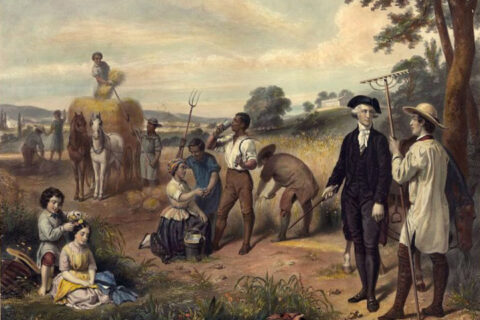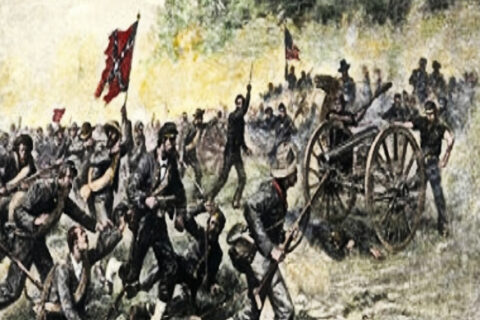Welcome to the second edition of “This Week in Southern History.”
NOTE: his week’s edition relies a great deal upon Baltimore, Maryland, being considered part of the South. Baltimore’s status as a Southern city is very debatable today. Keep in mind, however, that during the events written about below, Baltimore was indisputably a Southern city, populated by Southern people with a Southern cultural identity. Enjoy the article.
JULY 29
1864: Belle Boyd, Confederate spy, was arrested and detained in Washington D.C. Belle Boyd’s career as a spy began on July 4th, 1861, when she killed a federal soldier who planted a Union flag on her home in Martinsburg, Virginia (modern day West Virginia). What particularly enraged her was the soldier’s curses directed at her mother, which prompted her to shoot the soldier with a pistol.
The Union army exonerated her, due to the circumstances of the shooting and her youth (she was only fifteen), but Belle Boyd was kept under guard. While there, she flirted with a young officer and extracted information from him, which she sent to the Confederates via her slave girl. In 1862, she eavesdropped on Union General James Shields and his staff in the parlor of a Martinsburg hotel, and conveyed information of the federal numbers and dispositions to General Thomas “Stonewall” Jackson. Jackson used the information she gave him (after she arrived in his camp, her dress torn by bullet holes) to defeat Union forces at the Battle of Front Royal.
Boyd, after her arrest, was sent to Canada, where she married a Union naval officer and had a daughter. She remarried twice after his death in 1866, and died in 1900.
1932: President Herbert Hoover, with 500 infantry, 500 cavalry, and 1,000 policemen, dispersed the 43,000 demonstrators of the “Bonus Army” who were encamped in Washington D.C. The Bonus Army, which consisted mostly of World War One veterans and their families, was protesting US Government’s withholding of bonuses promised to soldiers during their service.
The largest outbreak of violence began when General George Patton, in command of the cavalry, paraded in front of the demonstrators. Believing the parade to be in sympathy, the veterans cheered – but their cheers changed to shouts of “shame! shame!” as the cavalry charged. General Douglass MacArthur, who commanded the infantry, ordered them to advance with bayonets fixed. After the veterans began to flee to their main camp, President Hoover ordered the army to stop – but MacArthur did not listen. Instead, he pressed on, deploying tear gas against the demonstrators.
By the end of the day, two had died, including a twelve month old baby who had been killed by the tear gas. Around seventy police officers and soldiers were wounded, along with over a thousand members of the Bonus Army.
The events of July 29, 1932 were incredibly damaging to the political career of President Hoover. He was defeated several months later by Franklin Delano Roosevelt in the presidential election of 1932.
JULY 30
1619: The House of Burgesses, the first representative assembly in the Americas, convened for the very first time in Jamestown, Virginia. The session, which lasted six days, included twenty two elected representatives, along with colonial officials. The meeting was cut short by (in Colonial Virginia style) an outbreak of malaria.

1729: The city of Baltimore, Maryland, was established. The name “Baltimore” was adopted from “Baltimore Manor,” the Longford estate of Irish nobleman Cecil Calvert. Calvert, who sat on the Irish House of Lords, was honored thus for having been instrumental in the founding of the Colony of Maryland.
The word “Baltimore” more or less translates to “town of the big house” in Gaelic.
The city of Baltimore, which until recent times was fiercely Southern in its culture and attitudes, played a significant role in Southern history. For example: the first bloodshed of the War Between the States (April 19, 1861) occurred there, when Baltimore citizens clashed with Union troops from New England.
1864: Union General Ambrose Burnside blew up a large mine which had been planted beneath Confederate lines during the Siege of Petersburg. The mine did its job – that of blasting a hole in the Confederate fortifications. The Union troops rushed for the gap, but found themselves trapped in the crater their own explosives had formed. The Confederates, led by General William Mahone, attacked the exposed federals and inflicted over 3,500 casualties before the Union troops retreated. This disaster forced the Union army to settle into a siege of Petersburg, which would drag on for eight more months.
JULY 31
1715: A Spanish treasure fleet, homeward bound from the New World, sank off the coast of Florida. Eleven ships and one thousand Spanish sailors were lost in the wreck. Much of the treasure from the fleet remains undiscovered, and silver from the sunken ships washes up on the shores of Vero Beach, Florida, to this very day.
AUGUST 1

1801: Marylander Andrew Sterett, captain of the USS Enterprise, defeated a Barbary ship after three hours of fighting. This was the first American victory of the First Barbary War, and not a single American was killed in the battle. Meanwhile, thirty Barbary pirates were slain, and another thirty were wounded.
Sterett, who had no formal instructions to take captured ships as prizes, actually let the enemy go after the battle (they were not particularly dangerous, however – their ship was badly damaged and only about twenty of their crew were unharmed after the battle).
Overall, the action of August 1st, 1801 provided a much needed morale boost to the fledgling US navy.
1966: A former marine sharpshooter killed fifteen people in Austin, Texas from a tower at UT (University of Texas). After an hour and a half of slaughter, the shooter was killed by police.
AUGUST 4
1964: Three “civil rights” agitators were found dead in Mississippi after disappearing on June 21.





Great article at the
lamecherry blogspot.
She’s had a lot of good info on the war of northern aggression lately.